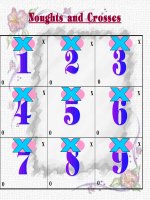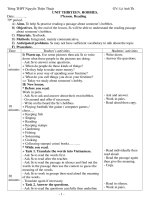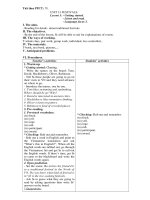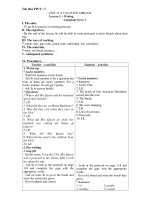E8 W 30 P86-88 UNIT 13
Bạn đang xem bản rút gọn của tài liệu. Xem và tải ngay bản đầy đủ của tài liệu tại đây (197.23 KB, 9 trang )
<span class='text_page_counter'>(1)</span><div class='page_container' data-page=1>
<b>Date of planning: 29/03/2019</b>
<b> Period: 86</b>
<b>UNIT 13: FESTIVAL</b>
<b>LESSON: 6- LANGUAGE FOCUS 1,2 </b>
<b>A.Objectives:</b>
<b>1. Aims: By the end of the lesson, students will be able to use the passive in the</b>
past, present perfect and future tense
<b>B. Teaching aids : Text book, pictures , poster.</b>
<b>2. Practice skill: </b>
- Practice reading, writing skill.
<b>3. The knowledge needs to get:</b>
<b>+ Standard knowledge: to use the passive in the past, present perfect and future</b>
tense
<b>+ Advanced knowledge: to use the passive in the past, present perfect and future</b>
tense to make sentences well.
<b>4. Basic language:</b>
- Vocabulary: jumble, scatter, jar, pull
<b> 5. Attitude:</b>
- Help ss to have good consciousness in order to use the passive in the past,
present perfect and future tense
<b>B. Teaching- aids: Textbook, pictures, posters, Cd, computer.</b>
<b>C. Methods:</b>
- Model-Talk-Practice, individual work, pair work
- Some techniques can be used: Matching, gap-fill, transformation drill
<b>D. Procedure :</b>
<b>I.Organization: ( 1 minute)</b>
<b>-</b> Greeting: Good morning!
<b>-</b> Who’s absent today?
<b>Class</b> <b>Date of teaching</b> <b>Absent students</b>
<b>8A</b>
</div>
<span class='text_page_counter'>(2)</span><div class='page_container' data-page=2>
<b>Teacher’s and Students’ activities</b> <b>Content</b>
<i><b>II. Warm up</b></i>
-T prepares 11 cardboards, numbered
from 1 to 11 on one side and the
words on the other side
-T divides ss into 2 teams and ask
each team to choose 2 numbers, one
in the first row, if the words in both
cards match in sequence of an
infinitive with its past participle, this
team will get a point
<i>III. New lesson:</i>
-T asks Ss to match the words in
column A with the forms in column B
-Ss work in pairs
-T calls Ss to give their answers
-T corrects
-T has Ss copy
-T asks Ss to look at language focus 1
on page 128
-T has Ss fill in the gaps with the
right form of the verbs in the box
-Ss work in pairs
-T calls on some Ss to write their
answers (only the verb forms)
-T corrects
-T asks Ss to look at language focus 2
on page 128 and 129 and fill in the
gaps with the right form of the verbs
in the box
-Correcting
<i><b>* Warm up/ Marks (5’)</b></i>
ØPelmanism
Infinitive Past participle
Put
Write
Hold
Make
Break
Put
Written
Held
Made
Broken
<i>III. New lesson:</i>
<b>Step 1. Presentation: 10’</b>
<i><b>Pre-teach </b></i>
ØMatching
The passive form
A B
Tenses Form
1. Present
Simple
2. Past simple
3. Future simple
4. Present
perfect
a. was/ were + PP
b. have/ has been
+PP
c. Is/ am/ are + PP
d. will/ shall + be +
PP
*Answer key:
1. c 2. A 3. D 4.b
<b>Step 2. Practice: 20’</b>
-Language focus 1
ØGap-fill
*Answer key:
a. were performed
b. was decorated/ put
c. is made
d. will be held
e. was awarded
f. was written
-Language focus 2(10’)
Gap-fill
*Answer key:
1. jumbled 4. Scattered
2. broken 5. Pull
</div>
<span class='text_page_counter'>(3)</span><div class='page_container' data-page=3>
<b>-Put the verb into the correct form, present </b>
<b>simple or past simple, active or passive. (6 </b>
<b>points)</b>
<b>1.It's a big factory. Six hundred people </b>
<b>(employ) </b> <b> there.</b>
<b>2.Water (cover) </b> <b> most of the </b>
<b>Earth’s surface.</b>
<b>3.The park gates (lock) </b> <b> at 7 </b>
<b>p.m. every evening.</b>
<b>4.The letter (post) </b> <b> a week ago </b>
<b>and it (arrive) </b> <b> yesterday.</b>
<b>5.The boat (sink) </b> <b> quickly but </b>
<b>fortunately everybody </b>
<b>(rescue) </b> <b> .</b>
<b>Step 3. Produce:6’</b>
Write 4 sentences using the passive voice.
Eg; A letter is written by me.
<i>IV.Summary: 1’</i>
T reminds ss of the passive form.
<i>V. Homework (2’)</i>
-Learnt by heart the words, grammar
-Do exercise and prepare: Language focus 3,4
* Evaluation :
………
………
………
………
………
………
……….
<i><b>Date of preparing: 29/3/2019 </b></i><b>Period 87. </b>
<b>Unit 13 - Festivals</b>
<b> Lesson 6: Language focus 3,4</b>
<b>A.Objectives:</b>
<b>1. Aims: - Help ss practice all structure grammar and do exercises of unit 13.</b>
<b>- By the end of the lesson , Ss will be able to practice in using reported speech, </b>
<b>compound words </b>
</div>
<span class='text_page_counter'>(4)</span><div class='page_container' data-page=4>
- Practice reading, writing skill.
<b>3. The knowledge needs to get:</b>
<b>+ Standard knowledge to practice in using reported speech, compound words to</b>
<b>rewrite the sentences.</b>
<b>+ Advanced knowledge: using reported speech, compound words to make </b>
<b>sentences well.</b>
<b>4. Basic language:</b>
- Vocabulary:
<b>5. Attitude:</b>
<b> - Help ss to have good consciousness in order to to practice in using reported </b>
<b>speech, compound words.</b>
<b>B. Teaching- aids: Textbook, pictures, posters, Cd, computer.</b>
<b>C. Methods:</b>
- Model-Talk-Practice, individual work, pair work
- Some techniques can be used: R & R, transformation.
<b>D. Procedure :</b>
<b>I.Organization: ( 1 minute)</b>
<b>-</b> Greeting: Good morning!
<b>-</b> Who’s absent today?
<b>Class</b> <b>Date of teaching</b> <b>Absent students</b>
<b>8A</b>
<b>8B</b>
<b>8C</b>
<b>II. Checking up + warm up (5 ):’ - Ask ss to change these sentences into passive </b>
voice:
1- She will buy a new bike. 2- They clean the floor everyday.
* Key: 1. A new bike will be bought by her. 2. The floor is cleaned by them
everyday.
* Form of checking: speaking and writing.
* T corrects and gives them marks.
<b>III. New lesson: </b>
<b>Teacher s activities</b>’ <b>Ss activities</b>’
<i><b>Step 1. Presentation</b></i>
<b>1.Vocabulary:</b>
- pay (v)
- plumber (n)
- industry (n)
- arrange (v)
- fight (v)
* Check: R & R
<b>2.Compound nouns: A rice cooking </b>
<b>festival</b>
<i><b> (article)(noun) (V-ing)</b></i>
<i><b>(noun)</b></i>
- To form compound adjective: noun + V-ing
<b>Step 2. Practice:</b>
<b>* LF 3 : P.130</b>
<i><b>Answer key</b></i>
a. A fire-making contest
b. A bull-fighting festival
c. A car-making industry
- Whole class
- Teacher – Ss
- Copy down new lesson.
- Work individually
- Look at the books and do
exercises
- Some Ss to go to the board
to do exercises.
</div>
<span class='text_page_counter'>(5)</span><div class='page_container' data-page=5>
d. A flower-arranging contest
e. A rice-exporting country
f. A. clothes-washing machine
<b>Step 1. Presentation:</b>
<b>3. Reported speech :</b>
<i><b>Model sentences :</b></i>
He said "I'm a plumber" ->direct speech
He said he was a plumber -> reported speech
<b>Changes:</b>
1. Tenses:
Direct speech Indirect-reported
speech
present simple
will / must / can past simplewould / had to / could
2.Pronouns:
Depend on the Subject of the main clause
3. Advs of time:
This that / now then / here
there
today that day / tomorrow the next
day
Yesterday the day before / ago before
<b>Step 2. Practice:</b>
<b>* LF 4 : P.130 : Transformation drill </b>
b. He said he could fix the faucets
c. He said the pipes were broken
d. He said new pipes were expensive
e. He said Mrs Thu had to pay him then
<b>Step 3. Production:</b>
-T asks Ss to use compound word and reported
speech to make sentences.
<b>IV.Summary:</b>
- Retell the main points of this lesson: What have
you learnt?
<b>V. Homeworks: </b>
- Redo all exercises.
- Learn by heart vocab and model sentences of
unit 13.
- Prepare for next lesson: Unit 14. Getting started,
Listen and Read.
+ T: lesson plan, poster, pictures, textbook cd,
cassette.
+ Ss: textbook, notebook, homework.
- Ss work in pairs and give
their answers .
- Some pairs practice each
exchange before going on to
another exchange .
-eg: flower-arranging,
bull-fighting,
car-making,rope-pulling, -sunbathing
-eg: Nam said his sister liked
cooking.
My friend told me he could
repair the bike himself.
- Some Ss retell the main
points of this lesson.
- Copy down homeworks
<i><b>*Evaluation: </b></i>
………
………
………
………
</div>
<span class='text_page_counter'>(6)</span><div class='page_container' data-page=6>
Date of preparing: 29/ 3/ 2019
<b>Period 88. </b>
<b> </b>
<b> Unit 14 - WONDERS OF THE </b>
<b>WORLD</b>
<b> Lesson 1 : Getting started - Listen and</b>
<b>read</b>
<b>A.Objectives:</b>
<b>1. Aims: By the end of the lesson, ss will be able to know some </b>
famous world landmarks and practice in reading to seek
information about a language game to complete a summary.
<b>B. Teaching aids : Text book, pictures , poster.</b>
<b>2. Practice skill: </b>
- Practice reading, writing skill.
<b>3. The knowledge needs to get:</b>
<b>+ Standard knowledge to know some famous world landmarks </b>
and practice in reading to seek information about a language
game to complete a summary.
<b>+ Advanced knowledge: Guess and tell about the wonders of </b>
the world.
<b>4. Basic language:</b>
- Vocabulary: - clue (n), bored (a), golden (a), suggest (v)
<b>5. Attitude:</b>
- Help ss to have good consciousness in order to get to know
some famous world landmarks and practice in reading to seek
<b>information about a language game to complete a summary.</b>
<b>B. Teaching- aids: Textbook, pictures, posters, Cd, computer.</b>
<b>C. Methods:</b>
- Model-Talk-Practice, individual work, pair work
- Some techniques can be used: Matching, rubout and
remember, gap fill, odering
<b>D. Procedure :</b>
<b>I.Organization: ( 1 minute)</b>
<b>-</b> Greeting: Good morning!
<b>-</b> Who’s absent today?
<b>Class</b> <b>Date of teaching</b> <b>Absent students</b>
</div>
<span class='text_page_counter'>(7)</span><div class='page_container' data-page=7>
<b>Teacher’s activities</b> <b>Ss’activities</b>
<b>II. Warm up:</b>
<b> * Getting started: Matching</b>
a. The Pyramid
b. Sydney Opera House
c. Stonehenge
<b>III. New lesson:</b>
<b> 1. Vocabulary: </b>
T elicits some new words:
- clue (n):
(translation)
- bored (a):
- golden (a):
- suggest (v):
+ Check voc
<b> 2. Presentation dialogue : </b>
(Listen and read – P.131-132)
<b>2. Gapfill : (Listen and read 2 P.132)</b>
1. game 2. place 3. clue 4.
Vietnam
5. American 6. Gold 7. right 8.
was
<b>3. Sets the scene:</b>
" Nga , Nhi and Hoa are playing a
language game called guessing game.
How does this game work? Rearrange
the statements in the right order of the
game"
- Puts the statements chart on the
board.
- Asks sts to read the statements and
put them in the right order.
- Calls on some pairs to go to the
board and write their answers
- wonder (n): kì quan
(example)
- gold gate bridge: cầu cổng vàng
(translation)
- clue (n): gợi ý
(example)
<b>II. While- reading:</b>
- Sts open their books and read the
dialogue on page 131, 132 while
listening to the tape
- Group work of 4/5 Ss
-Some groups to give
their answers and
correct
- Copy down new
lesson.
- Repeat in chorus.
- Asks sts to open their
books and read the
dialogue on page 131,
132 while listening to
the tape
- Plays the tape.
- Checks if sts' guesses
are right or not
- Have sts to copy
statements in the right
order
T – Ss
- Students listen to the
dialoge then answer
the questions
Groupwork of 4/5 Ss
T – Ss
Pair work
- Ss to write a story
using the information
from the dialogue .
Individual work
</div>
<span class='text_page_counter'>(8)</span><div class='page_container' data-page=8>
<b>1. Ordering sentences :</b>
<i><b>How to play the guessing game?</b></i>
1. B asks questions to find out what it
is
2. A thinks of a famous person or place
3. B wins if he/she can guess the
correct answer
4. A gives B a clue
5. B loses if he/she can't guess the
correct answer
6. A only can answer "yes" or "no"
<i><b>->Key: 2 - 4 - 1 - 6 - 3- 5</b></i>
<i><b>3. Grammar : Model sentences: </b></i>
<i><b>Language focus 3 p.137</b></i>
I don't know how to play it
<b>* Form: S + V + question word </b>
<b>+ to infinitive...</b>
<b>* Use: Reduced form of an indirect </b>
<b>question </b>
<i><b>Ex: I don't know how can I play </b></i>
<b>it</b>
<b> how to play it</b>
<b>Please tell me where I can go </b>
<b>during the visit</b>
<b> where to go</b>
<b> A </b>
<b>B</b>
<b>Eg: I don't know how I can play it</b>
<b> to play it</b>
b. Nga showed Nhi where to get tickets
c. Nga pointed out where to buy
sourvenirs
d.Nga advised Nhi how to go from My
Son to H.An
e. Nga told Nhi what to do there during
the visit
<b>III. Guessing game : Teacher: It is a </b>
wonder and it is in Asia
St:(guess)
Teacher : yes/ no
the words of phrases by
matching.
- Asking sts to read the
summary again
- Write the words on the
board
- Asks sts to match the
words in column A with
their explanations in
column B
- Asks some sts to give
their answers
- Retell the main points.
- Listen and copy down
homeworks.
<b>IV. Summary:</b>
- Retell the main points of this lesson: What have you learnt?
<b> *Homework: </b>
</div>
<span class='text_page_counter'>(9)</span><div class='page_container' data-page=9>
- Prepare well for the next period: Speak + Listen
+ T; Lesson plan, pictures, textbook. + Ss: homework.
<b> *Evaluation:</b>
</div>
<!--links-->









